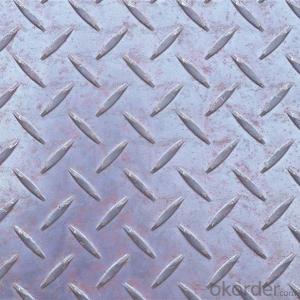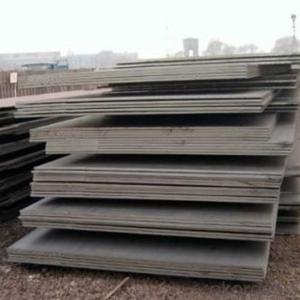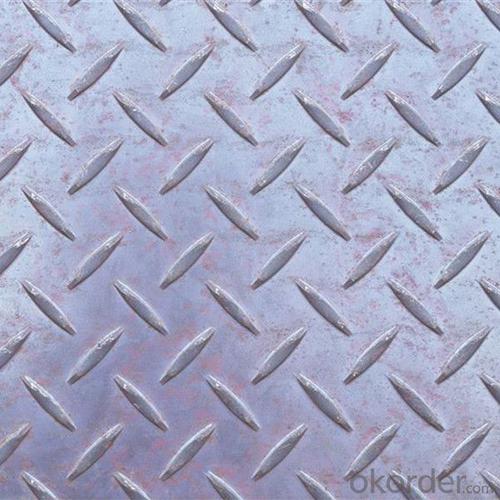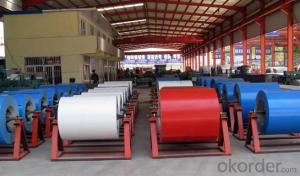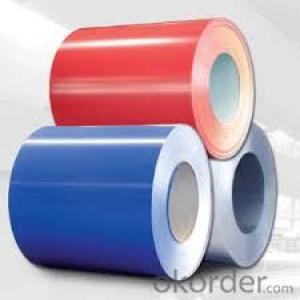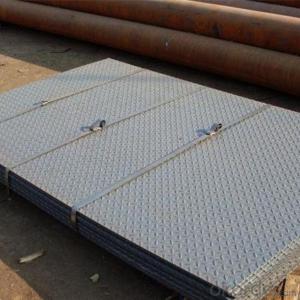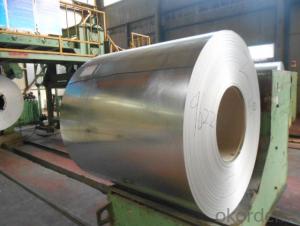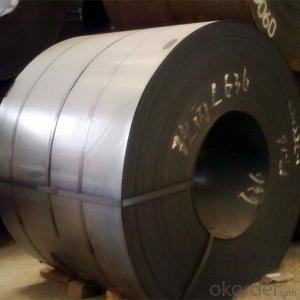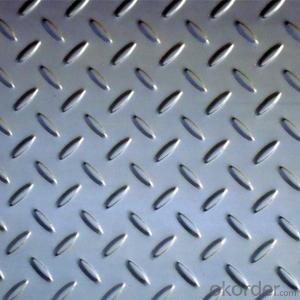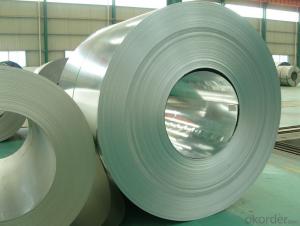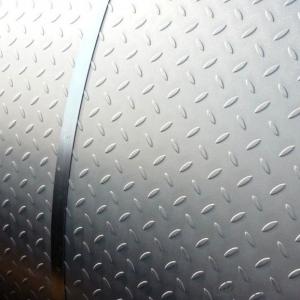Prime Hot Rolled HR Steel Chequered Sheet China Supplier
- Loading Port:
- China main port
- Payment Terms:
- TT OR LC
- Min Order Qty:
- 23 m.t.
- Supply Capability:
- 10000 m.t./month
OKorder Service Pledge
OKorder Financial Service
You Might Also Like
Specification
Product Introduction
Commodity | Chequered steel sheet plate |
Grade | 201,202,304,304L,309S,310S,316,316L,316Ti,317L,321,347H,409,409L,410,420,430,etc |
Brand | TISCO,BAOSTEEL,POSCO,JISCO,LISCO |
Certification | ISO,SGS,BV,etc |
Thickness | 0.3mm-60mm |
Width | 1000mm,1219mm(4feet),1250mm,1500mm,1524mm(5feet), 1800mm,2200mm or as your requirements |
Length | 2000mm,2440mm(8feet),2500mm,3000mm,3048mm(10feet), 5800mm, 6000mm or as your requirements |
Surface | NO.1, 2D, 2B, BA,NO.3, NO.4,NO.240,NO.400,Hairline(HL),8K(mirror),Brushed |
Standard | ASTM,AISI,SUS,JIS,EN,DIN,BS,GB,etc |
Delivery time | 5 days after confirming the order |
MOQ | 1 ton |
Package | Bundles, seaworthy wooden cases.With or without edge protector, steel hoop and seals, or as per customers' requirements. The inner size of container is below: 20ft GP: 5.8m(length) x 2.13m(width) x 2.18m(high) about 23MTS 4 0ft GP: 11.8m(length) x 2.13m(width) x 2.18m(high) about 27MTS 40ft HG: 11.8m(length) x 2.13m(width) x 2.72m(high) about 27MTS |
Payment term | L/C at sight or 30% TT as deposit and the balance paid against copy of B/L |
Applications | architectural decoration, luxury doors, elevators decorating, metal tank shell, ship building, decorated inside the train, as well as outdoor works, advertising nameplate, the ceiling and cabinets, aisle panels, screen, the tunnel project, hotels, guest houses, entertainment place,kitchen equipment,light industrial and others. |
Advantages | showing the splendor of your quality, wear-resistant as well , strong corrosion resistance and decorative effect, durable and beartiful in good taste. |
2.Product Photos
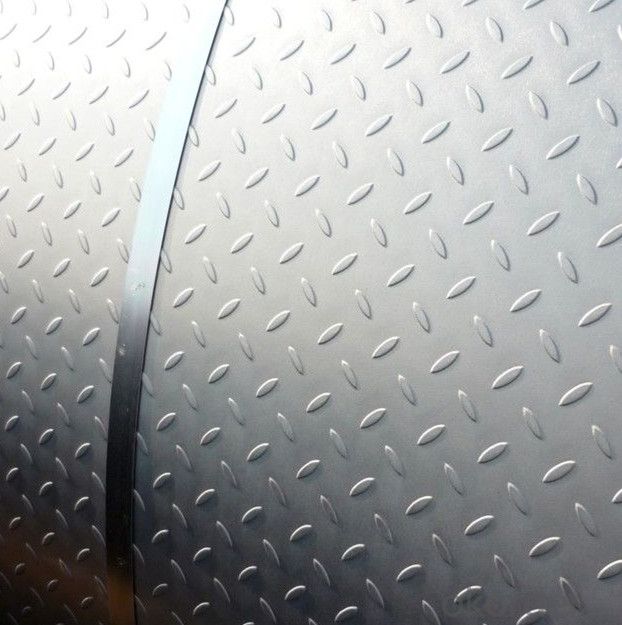
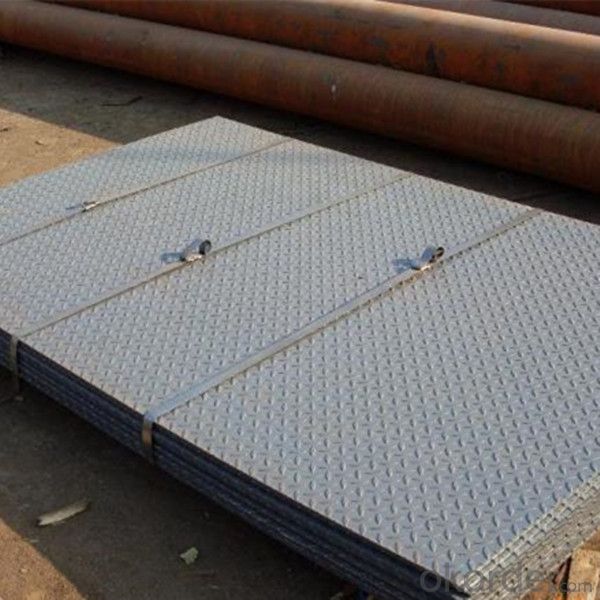
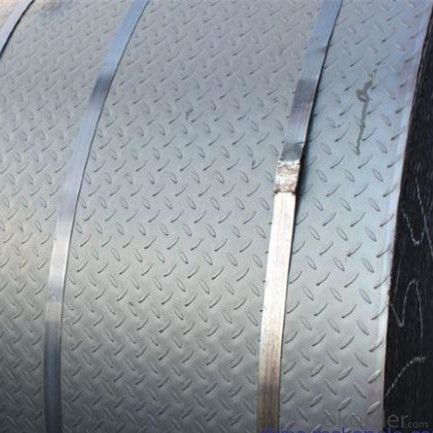
3.Service
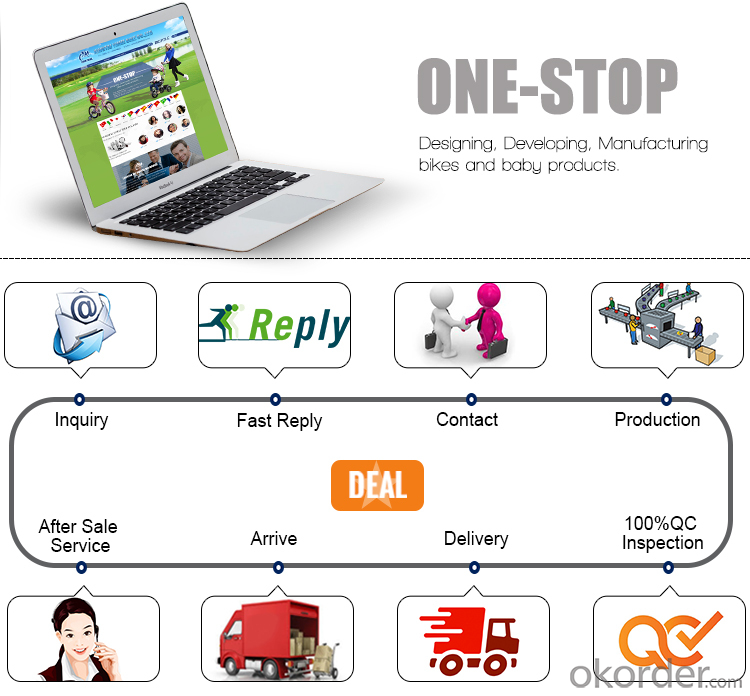
- Q: What are the different methods of recoiling steel coils?
- Depending on the specific requirements and characteristics of the material, there are several methods employed for recoiling steel coils. Some commonly used techniques include: 1. Slitting: This method entails cutting the steel coil into narrower strips, which can then be recoiled. Rotary knives or circular saws are typically utilized in the slitting process, allowing for precise control over the width. 2. Rewinding: This approach involves unwinding the steel coil and subsequently rewinding it onto a new coil mandrel. It is commonly employed when resizing the original coil is necessary or when reconditioning a damaged coil. 3. Recoiling with a tension control system: This method passes the steel coil through a series of tension control rollers that apply a controlled amount of tension to the material. Consequently, the recoiling process is smooth and even, minimizing the risk of coil distortion or damage. 4. Recoiling with a slitter head: Combining the slitting and recoiling processes, this method employs a slitter head to simultaneously cut the steel coil into narrower strips and rewind them onto separate coils. 5. Recoiling with a looping pit: This technique involves feeding the steel coil through a looping pit, allowing for the accumulation of material as the coil is recoiled. This helps maintain a consistent line speed and tension throughout the recoiling process. Each of these methods possesses distinct advantages and is suitable for various applications. The choice of recoiling method depends on factors such as desired coil dimensions, material thickness and strength, and the required level of precision and quality.
- Q: I am working on a hydrogen generator, but the stainless steel I am using corrodes and turns the water brown. Can anyone tell me if there is stainless steel that does not corrode, and if so, what is it called and where can I get some.Thank you.
- Maybe okorder Hope this can help you.
- Q: What are the different types of steel alloys used in coils?
- Coils commonly employ various types of steel alloys, each possessing unique properties and characteristics. Some frequently used types include: 1. Carbon Steel: As the most fundamental and widely utilized steel alloy in coils, it boasts low carbon content and renowned strength and durability. Carbon steel coils find extensive application in areas demanding high strength, such as automotive parts, construction materials, and machinery components. 2. Stainless Steel: Comprising an iron, chromium, and other element alloy, stainless steel coils exhibit exceptional resistance to corrosion, formidable strength, and heat resistance properties. They are typically employed in scenarios where shielding against corrosion and staining is pivotal, such as kitchen appliances, medical equipment, and transportation components. 3. Galvanized Steel: Galvanized steel coils are formed by coating regular carbon steel with a layer of zinc, furnishing excellent corrosion resistance and safeguarding the underlying steel from rust. Commonly utilized in outdoor settings like roofing, fencing, and automotive body parts. 4. Alloy Steel: Alloy steel coils are manufactured by incorporating diverse alloying elements like manganese, nickel, chromium, or molybdenum into carbon steel, thereby enhancing the steel's strength, hardness, and wear resistance. These coils frequently find application in industries necessitating high strength and toughness, such as machinery, tools, and construction equipment manufacturing. 5. Electrical Steel: Electrically specialized steel coils are designed explicitly for employment in electrical equipment like transformers and electric motors. These coils possess low electrical resistance and high magnetic permeability, facilitating efficient electricity conduction and magnetic field generation. Typically constructed from a silicon alloy, which enhances electrical and magnetic properties. In conclusion, the selection of a steel alloy for coils hinges upon the specific requirements of the given application, encompassing factors like strength, corrosion resistance, electrical conductivity, and heat resistance.
- Q: How are steel coils inspected for yield strength using tensile testing?
- Steel coils are inspected for yield strength using a testing technique called tensile testing. Tensile testing involves subjecting a sample of the steel coil to controlled tension until it reaches its breaking point. This test helps determine various mechanical properties of the steel, including yield strength. To inspect steel coils for yield strength using tensile testing, a small strip of the coil is cut and prepared for testing. The strip is placed in a tensile testing machine, which consists of two grips that firmly hold the strip at opposite ends. The machine then applies a steadily increasing force to the strip, causing it to elongate until it ultimately breaks. During the test, the machine measures the force applied and the elongation of the strip. The yield strength is determined by identifying the point on the stress-strain curve where the material begins to deform plastically, or exhibit permanent deformation without any increase in load. The yield strength is typically reported as the stress required to cause a specific amount of plastic deformation, commonly 0.2% or 0.5%. This value represents the maximum stress that the steel can withstand without permanent deformation occurring. By conducting tensile testing on a sample of the steel coil, it is possible to determine its yield strength. This information is crucial for ensuring the quality and reliability of the steel coil, as it indicates the maximum stress it can withstand before permanent deformation occurs. Additionally, this testing method allows for the evaluation of other mechanical properties, such as ultimate tensile strength, elongation, and modulus of elasticity, providing a comprehensive understanding of the steel's performance characteristics.
- Q: How long can steel coils be stored?
- Steel coils can be stored for an extended period if proper storage conditions are maintained. The duration of storage depends on factors such as coil quality, environmental conditions, and any specific storage requirements determined by the manufacturer.
- Q: How do steel coils contribute to the oil and gas industry?
- Steel coils are an essential component in the oil and gas industry as they are used to manufacture various equipment and structures like pipelines, storage tanks, and drilling rigs. These coils provide the necessary strength, durability, and resistance to corrosion required for the harsh operating conditions in the industry. Additionally, steel coils are crucial in the transportation of oil and gas as they are used in the construction of tankers and pipelines, ensuring the safe and efficient movement of these valuable resources.
- Q: What are the common coil edge finishes?
- The common coil edge finishes include mill edge, slit edge, and deburred edge.
- Q: How are steel coils inspected for flatness using optical sensors?
- Steel coils are inspected for flatness using optical sensors by employing a system known as optical flatness measurement. This method involves the use of high-resolution cameras that capture images of the steel surface as it passes through the inspection line. Firstly, the steel coil is unwound and passed over a roller table. As it moves, the optical sensors are positioned above the coil to capture images at regular intervals. These sensors typically consist of a combination of laser line projectors and high-resolution cameras. The laser line projectors emit a thin, straight line of laser light across the width of the steel coil. This laser line acts as a reference plane for measuring the flatness of the steel surface. The high-resolution cameras then capture images of the laser line as it interacts with the steel coil. The captured images are then analyzed using advanced image processing algorithms. The algorithms analyze the deformation of the laser line on the steel surface and calculate the deviations from the flat reference plane. These deviations indicate any irregularities or variations in the flatness of the steel coil. The optical sensors can accurately detect even the slightest deviations in flatness, measuring them in micrometers or even smaller units. This enables manufacturers to identify and rectify any flatness issues in the steel coils before further processing or shipment. In addition to measuring flatness, optical sensors can also detect other surface defects such as waviness, scratches, or dents. By incorporating multiple cameras and laser line projectors from different angles, a comprehensive inspection of the steel coil's surface can be achieved. Overall, the use of optical sensors for inspecting steel coil flatness provides a fast, accurate, and non-contact method. By detecting and rectifying any flatness issues early in the production process, manufacturers can ensure the delivery of high-quality steel products to their customers.
- Q: How are steel coils inspected for chemical composition?
- The chemical composition of steel coils is examined using spectroscopy, a process that involves the utilization of a spectrometer. This instrument analyzes the light emitted or absorbed by a sample to determine its chemical makeup. Normally, a small portion of the coil is taken and prepared for analysis in the case of steel coils. This portion is then placed in the spectrometer, where a beam of light is emitted onto it. The light interacts with the atoms and molecules in the sample, causing specific wavelengths of light to be emitted or absorbed. The spectrometer measures the intensity of the emitted or absorbed light at different wavelengths and generates a spectrum, which is essentially a distinct fingerprint for the sample. This spectrum is then compared to a database of known spectra for various elements and compounds to ascertain the chemical composition of the steel. Through spectroscopic analysis, the presence and concentration of different elements like carbon, manganese, phosphorus, sulfur, and other trace elements in the steel can be identified. These elements have a significant impact on the steel's properties, strength, and suitability for different applications. Ensuring that the steel complies with the required specifications and standards, inspection for chemical composition is crucial in the steel industry. Any deviation from the desired chemical composition can potentially compromise the steel's performance and result in structural failures or other defects. In conclusion, spectroscopy offers a highly precise and dependable method for examining the chemical composition of steel coils. This aids in maintaining the quality and integrity of the steel products.
- Q: Can steel coils be coated with barcodes?
- Yes, steel coils can be coated with barcodes.
Send your message to us
Prime Hot Rolled HR Steel Chequered Sheet China Supplier
- Loading Port:
- China main port
- Payment Terms:
- TT OR LC
- Min Order Qty:
- 23 m.t.
- Supply Capability:
- 10000 m.t./month
OKorder Service Pledge
OKorder Financial Service
Similar products
Hot products
Hot Searches
Related keywords
